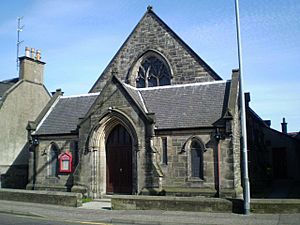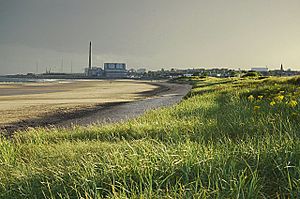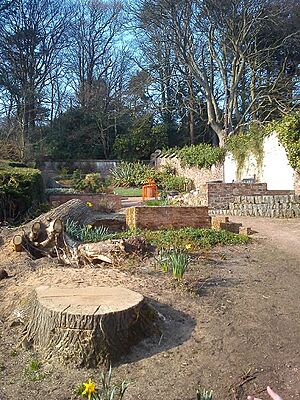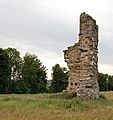Leven, Fife facts for kids
Quick facts for kids Leven
|
|
|---|---|
| Population | 10,087 |
| OS grid reference | NO384007 |
| Civil parish |
|
| Council area | |
| Lieutenancy area |
|
| Country | Scotland |
| Sovereign state | United Kingdom |
| Post town | LEVEN |
| Postcode district | KY8 |
| Dialling code | 01333 |
| Police | Fife |
| Fire | Fife |
| Ambulance | Scottish |
| EU Parliament | Scotland |
| UK Parliament |
|
| Scottish Parliament |
|
Leven is a lovely seaside town in Fife, Scotland. It's located on the coast of the Firth of Forth, right where the River Leven meets the sea. Leven is about 8.1 miles (13 km) north-east of Kirkcaldy and 6.4 miles (10.3 km) east of Glenrothes.
In 2022, about 10,087 people lived in Leven. The town is part of a bigger area called Levenmouth, which has a total population of 37,651 people.
Contents
History of Leven
The name "Leven" comes from an old language called Pictish. It means "flood." The nearby Loch Leven, which is a flood lake, gave its name to both the river and the town.
People believe a settlement first grew near the mouth of the River Leven. This was close to an area called Scoonie Brae. An old church called "scoyne" was found there. Around the mid-11th century, a bishop gave this church to a group of religious people called Culdees from Loch Leven. Later, by the end of the 11th century, another bishop took over the village and church.
The town of Leven was first mentioned in records around the mid-1400s. These records called the town "levynnis-mouth." They talked about needing to fix the town's monastery and a local landowner becoming the keeper of the harbour.
In 1854, the Leven Railway opened. This train line connected Leven to a main railway line that went from Edinburgh to Aberdeen. This helped Leven become a popular place for tourists, especially those from Glasgow.
Later in the 1800s, the Leven Railway became part of a bigger loop line. This line connected Thornton Junction and Leuchars Junction, going through St Andrews. The railway between Leven and St. Andrews closed in 1965. The line between Leven and Thornton Junction closed for goods in 1966 and for passengers in 1969.
Good news! In 2019, a plan was approved to re-open the town's railway station. This re-opening happened on June 2, 2024. Before that, the closest train station was Markinch railway station.
Fun Things to Do in Leven
Tourism is a big part of Leven's economy. Many people visit the area. There are several large caravan parks, hotels, and guest houses. The nearby villages of Lundin Links and Lower Largo also have many places for visitors to stay.
The beautiful coast and long sandy beaches are the main reasons people come to Leven. The town has a nice beach promenade with playparks and other fun things, like an indoor Kids Action Zone. This promenade is part of the Fife Coastal Path, a long walking trail that stretches over 150 miles (240 km).
You can also enjoy family activities and walks in the big parks at Letham Glen and Silverburn. Letham Glen has a crafts centre and woodland walks. Silverburn has pretty gardens and views of the coast.
Golf is another popular activity. There are two golf courses in Leven, called Scoonie and Leven Links. Another course is a short walk away in Lundin Links. Leven Links has even been used for qualifying rounds for the Open Championship, a very famous golf tournament, when it's held in St Andrews.
A special heritage railway has been built near the Burnmill industrial area. It runs along the old Leven-Thornton train line. Trains run for half a mile between April and October, and there's a special Santa train in December. The Fife Heritage Railway is the first of its kind in Fife since 1992.
The Levenmouth Leisure Centre is a great place for sports and swimming, no matter the weather. It has a big, modern indoor swimming pool. If you like history, you can visit the Heritage Centre in Methil, which is only a 15-minute walk from Leven town centre.
Leven town centre is a main shopping area for many nearby places. It has big supermarkets and other shops, as well as local stores. You'll also find many restaurants and cafes there.
Jobs and Economy
Levenmouth used to have poor connections to the main train and road networks in Scotland. This was especially true after the last railway line closed in 1969. This happened at the same time as the coal mining industry ended, which greatly affected Methil as a major port.
However, things are changing! On June 15, 2021, the transport minister announced that train services would return to Leven and Levenmouth. A new electrified dual-track railway was built. Services started again on June 2, 2024, thanks to a £116 million investment from the Scottish Government. This connects Leven to the main train line at Thornton.
Even before the railway re-opened, there were good bus links to the main train station in Kirkcaldy (8 miles or 13 km away). There are also regular express bus services to the pretty villages in the East Neuk and to St Andrews. A new bus station was recently built in the centre of Leven.
The main road through Fife, the A92, goes around Leven. But Leven is connected to Kirkcaldy by the A915 Standing Stane Road. It also has a fast road link to Glenrothes on the A915, which continues to St Andrews.
There aren't many big employers left since the coal mining industry closed. The main companies that provide jobs now are Diageo, a drinks manufacturer with a big bottling plant in Leven, and supermarkets like Sainsbury's, Lidl, and Aldi.
Schools in Leven
Leven has three primary schools. Two of them are non-religious: Mountfleurie and Parkhill. The third one, St Agatha's, is a Catholic school.
Parkhill Primary School opened in 1910. It started as a school for very young children and then began accepting primary school pupils in 1957. Mountfleurie Primary School opened in 1957 and added a department for infants in 1974. It also has a special class for speech and language, which started in 1990. St Agatha's RC Primary School moved to its current location in 1975. Students come from a wide area, from East Wemyss to Lower Largo.
For secondary school, most children from Leven go to Levenmouth Academy. Before this, students went to either Kirkland or Buckhaven high schools. These schools joined together to form Levenmouth Academy.
Famous People from Leven
- Charles Augustus Carlow (1878–1954) – An engineer and owner of coal mines.
- David Gibb (1883–1946) – A mathematician and astronomer.
- Professor Alexander Robert Horne (1881–1953) – An engineer and writer.
- Dr Douglas Haig McIntosh (1917–1993) – A meteorologist.
- Jean Redpath (1937–2014) – A Scottish folk singer and teacher.
Gallery
-
Leven's memorial to the War dead
Twin Towns
 Leven is twinned with Holzminden, a town in Germany.
Leven is twinned with Holzminden, a town in Germany. Leven is twinned with Bruges, Gironde, a town in France.
Leven is twinned with Bruges, Gironde, a town in France.













